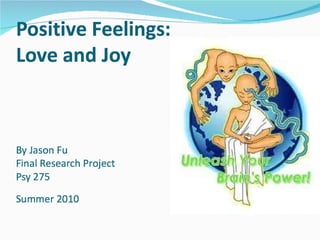Final project on_love_and_joy
•Télécharger en tant que PPT, PDF•
2 j'aime•895 vues
Signaler
Partager
Signaler
Partager

Recommandé
Recommandé
Contenu connexe
Tendances
Tendances (16)
Personality profile for drug addicts and non addicts in

Personality profile for drug addicts and non addicts in
En vedette
En vedette (20)
Bartering for Hotels and Resorts - The Ormita Commerce Network: Ormita

Bartering for Hotels and Resorts - The Ormita Commerce Network: Ormita
Las posibilidades del_blog_como_elemento_de_apoyo_y_refuerzo_en_el_aprendizaje

Las posibilidades del_blog_como_elemento_de_apoyo_y_refuerzo_en_el_aprendizaje
Love by Helen Fisher, a presentation for February 14

Love by Helen Fisher, a presentation for February 14
Cátedra Abierta USBmed: Contenidos digitales para el aprendizaje

Cátedra Abierta USBmed: Contenidos digitales para el aprendizaje
Similaire à Final project on_love_and_joy
Similaire à Final project on_love_and_joy (20)
Our evolved unique feel good circuits makes humans different from apes

Our evolved unique feel good circuits makes humans different from apes
The Biology of Love: Dopamine, Serotonin, and Oxytocin

The Biology of Love: Dopamine, Serotonin, and Oxytocin
Plus de Christine Moon
Plus de Christine Moon (13)
Final project on_love_and_joy
- 6. Brain in love (by image)
- 7. Brain in love (by image) The fact that the raphe nucleus region of our brain literally rewards us with a shot of the lovely calming hormone, serotonin, may be news. Hormones produced by the ventral pallidum relate to attachment and reduced stress, a feel good, all is well part of the love bonding. The VTA, ( ventral tegmental) works like a banana split for a job well done - a reward system in the brain, making dopamine and sending it to different areas of the brain http://www.goodreads.com/story/show/35559-valentine-s-day-the-science-of-romance
- 8. Brain in love (by image) Love is any of a number of emotions and experiences related to a sense of strong affection and attachment. The word love can refer to a variety of different feelings, states, and attitudes, ranging from generic pleasure to intense interpersonal attraction. http://commons.wikimedia.org/wiki/File:Chemical_basis_of_love.png
- 9. Brain in Love (by image) The chemicals that race around in our brain when we're in love serve several purposes, and the primary goal is the continuation of our species. Those chemicals are what make us want to form families and have children. Once we have children, those chemicals change to encourage us to stay together to raise those children. So in a sense, love really is a chemical addiction that occurs to keep us reproducing. http://nwprthomblog.blogspot.com/2008_08_01_archive.html
- 10. Brain in love (by image) These brain scans show that maternal and romantic love share similar activated and deactivated areas in the brain. http://blogs.discovermagazine.com/cosmicvariance/2010/02/
- 11. Brain in love (by image) Activation of the brain’s ventral tegmental area in longterm partners suggests that romantic love can persist. (Brain image courtesy of Stony Brook State University of New York and Albert Einstein College of Medicine) http://www.dana.org/news/brainwork/detail.aspx?id=14410
- 12. Brain in love (by image) A new study suggests that an area of the brain known as the caudate is associated with passion. The caudate gathers and processes information from different circuitries while in love. http://www.nytimes.com/2005/05/31/health/psychology/31love.html